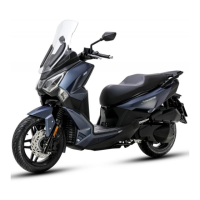
Do you have a question about the Sym JOYRIDE 300 2022 and is the answer not in the manual?
| Cooling System | Liquid Cooled |
|---|---|
| Transmission | CVT |
| Front Suspension | Telescopic Fork |
| Front Brake | Disc |
| ABS | Yes |
| Seat Height | 770 mm |
| Engine | Single Cylinder |
| Max Torque | 26 Nm @ 6, 000 rpm |
| Fuel System | Electronic Fuel Injection |
| Rear Brake | Disc |
| Front Tire | 120/70 |
| Rear Tire | 140/70 |
| Dry Weight | 118 kg |
| Height | 1440 mm |
| Rear Suspension | Dual shock absorbers |
Guidance on proper motorcycle operation and its benefits.
Importance of initial checks and maintenance before delivery.
Key reminders for safe riding, including helmet, clothing, and handling.
Warning about the hot exhaust pipe and precautions to avoid burns.
Caution against modifying the motorcycle, which voids warranty and affects performance.
Importance of relaxed posture, body gravity, and handling on different roads.
Advice on how load affects handling and caution against overloading.
Warnings against storing flammable materials and improper loading.
Emphasizes using genuine parts for optimal performance and service life.
Explanation of the instrument panel gauges and warning lights.
Details on fuel meter, low fuel warning, and engine oil replacement lights.
Caution regarding the smart lock system and using the switch key.
Steps to activate, disarm the anti-theft system and unlock the vehicle.
Explains automatic locking, alarm modes, and LED indicators.
Procedures for PKE (Passive Keyless Entry) and IMMO unlocking.
System protection against repeated key presses or forced locking.
Warnings about operating the ignition switch, especially when the engine is running or stopped.
Operation of starter, high/low beam, hazard warning, and engine stop switches.
Operation of the passing light and horn.
How to use turn signals for turning and lane changes.
Information on the under-seat storage box, capacity, and usage advice.
Warning not to hang helmets while riding, to avoid damage and ensure safety.
Steps for opening and closing the fuel tank cap, including alignment marks.
Safety advice during refueling, such as engine shutdown and avoiding overfilling.
Guidelines for effective and safe braking, including simultaneous use of brakes.
Explanation of how to use engine braking for speed reduction.
Essential checks before starting the engine, like oil, fuel, and brake application.
Steps for starting the engine using the starter button or kick starter, including cautions.
Advice on occasionally using the kick starter to maintain its function.
Steps for safely starting to move, including using turn signals and checking traffic.
Explanation of how to use the throttle for increasing or decreasing speed.
Steps for approaching a parking spot, signaling, and braking.
Instructions for shutting off the engine, using the main stand, and locking the steering.
Warning to park in a safe location that does not interfere with traffic.
A checklist of items to inspect before riding, including engine oil, brakes, and tires.
Procedure for checking and changing engine oil, including oil type and capacity.
How to check the fuel level and required fuel type.
Procedures for inspecting and changing transmission oil, including recommended oil.
How to check the free play of brake levers and pedals.
Steps for adjusting brake free play using adjustment nuts, including wear indicators.
Inspecting brake lines, connections, and overall condition.
Checking brake fluid level and procedure for adding fluid, with cautions.
How to check and adjust throttle cable clearance for smooth operation.
Procedure for cleaning battery terminals and removing corrosion.
Cautions for storing the battery and preventing discharge during long periods of inactivity.
Steps for checking tire condition, inflation, and foreign objects.
Checking tread wear and warnings about abnormal tire pressure affecting control.
Inspecting front shock absorbers for damage, noise, and looseness.
How to check fuses, replace blown ones, and cautions regarding proper specifications.
Procedure to test turn signals and horn for proper operation.
How to check if headlights and taillights are functioning correctly.
How to test the brake light and cautions regarding bulb specifications.
Areas to check for fuel leaks, including tank, hose, and carburetor.
Checking lubrication of body pivot points like stands and levers.
Steps to check, gap, and tighten the spark plug.
Procedure for cleaning the air cleaner element and related cautions.
Guide to diagnose why the engine may not start, checking ignition, fuel, brakes, and throttle.
Recommended fuel type and suggestion for air/fuel ratio adjustment at high altitudes.
Specifies the recommended oil for the transmission system.
Precautions before and during the initial movement, like throttle control and side stand.
Warnings against sudden actions and advice for riding in wet conditions.
A table detailing inspection, cleaning, and replacement tasks at various kilometer intervals.
Explanations of codes (I, R, C, L) and remarks for maintenance based on usage and environment.
Key physical specifications, engine type, and performance data.
Specifications for tires, brakes, lights, oil capacity, fuses, and battery.
